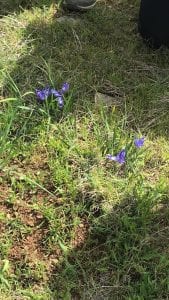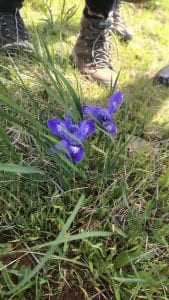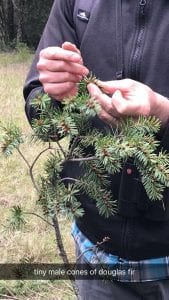Cassandra Odulio
- Date: March 7, 2019
- Location: Mount Tamalpais, Ridgecrest, 37°55’44.0″N 122°35’02.3″W
- Habitats seen: grassy hills, stands of shrubs, cliffs, woods,
- Weather: partly cloudy but still sunny, very windy.
We made multiple stops on this field trip. The first was at the Homestead Fire Road, where we saw poison hemlock, Bermuda buttercups, coyote brush, yellow mats, amole, and checker mallows, among others. We got back in the car and headed to our second stop, which was mostly grassy hills and serpentine rocks. Plants we saw in that area included: leather oak, tanoak, and gold cup live oak. Eventually we reached West Ridgecrest Boulevard, which has a view of the San Andreas Fault. We saw Douglas firs, and we walked into the woods to find the Fairy slipper orchid. Afterward, we took one last car ride to the Mount Tamalpais Watershed area, where we saw chain ferns, rushes, bedstraw, wild strawberries, and the rattlesnake plantain orchid. We also took a very nice class photo today, which was very sweet! Making memories.
Iris macrosiphon – Ground iris
This plant is in the Family Iridaceae, and it is herbaceous and low to the ground, which is why it is known as the ground iris. The leaves are basal, long, and thin. These flowers are blue, but they can also be cream, yellow, or lavender. The petals have a light pattern on them, and apparently, some of the petal-looking structures are actually pistils.
Pseudotsuga menziesii – Douglas fir
Douglas fir trees are in the Family Pinaceae. The genus name “pseudotsuga” means fake hemlock, due to the fact that Nineteenth-century botanists had problems in classifying Douglas-firs and would sometimes classify them in the Tsuga genus. One key morphological feature is that they have singular needles coming off the stem. The male cones are tiny, and the female cones have special bracts that can be easily identified. According to a California Native American myth, Douglas firs were kind enough to let mice hide in their cones from a great forest fire, and to this day, you can see tiny hind legs and tails peeking out of the cones.
Sanicula arctopoides – Yellow mats
These herbaceous plants are in the Family Apiaceae. Another common name for them is Footsteps of Spring, which I think is adorable. They grow low on the ground, and are bright yellow, almost neon, like a Sharpie highlighter. Even the leaves are yellowish-green. They have tiny flowers in umbel inflorescences, and around the inflorescences are bracts that look like big petals.










